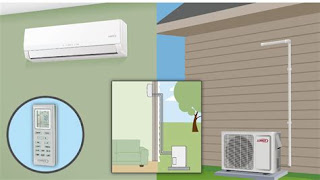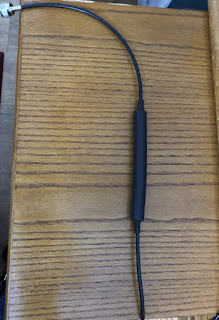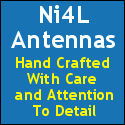Posts Tagged ‘RFI’
 RFI mystery
RFI mystery
 |
| RFI issue spread across the band |
- Switched to my active antenna and I still had the issue.
- I change to battery power only and I still had the issue.
- I turned off the main AC circuit breaker to the house and I still had the issue while using battery power obviously. Oh and an added note.....my dear wife was not happy about that.
 |
| Sometimes the RFI stops but then soon starts |
-Switched to my dummy load and the issue was gone but so were all signals.
So from the above, it seems it is being picked up by the antenna and not something within my home. At this point, I have not tried to pinpoint times as to when or if the RFI is present. I will be within the next few weeks paying very close attention to times when I am on and if the RFI is present or not. Until then I wanted to see if I was able to solve the issue with the Icom 7610's filtering. The choices I have are the noise reduction option or the noise blanker option. As a side note, my previous rig was the Elecraft K3 and it had amazing filtering for RFI issues. It was time to put the Icom 7610 to the test and see how it performed. I tried both the NR and NB and found it was the NB (noise blanker) that did the trick. I was able to totally remove the RFI and still hear the CW signal that was getting buried in the noise. Within the noise blanker settings, you can adjust the level, depth and width. I did find certain settings worked better than others at removing the offending RFI. I did change over to my Elecraft KX3 just to see how it dealt with the RFI and I was shocked how it really was not able to remove the RFI and the Icom 7610 won hands down!
 |
| The split-mini |
 Toroid choke adventure
Toroid choke adventure
 |
| Snap on Choke |
A few weeks ago I was on my radio and once again I experienced some RFI issues with my PC and my morse code key. On my PC the mouse was moving all over the screen and the morse code key when using it I had extra dots and dits being sent. I use snap on chokes but I have seen in the past the chokes have become unsnapped and the choke is not able to do its job 100%. After my mouse and morse code key issues I move my radio desk out to look behind and have a look at the installed chokes. I was not surprised to see a number of chokes that were unsnapped. It was time for me to take this issue head on and solve it once and for all. I decided to put toroid chokes on each end of each
 |
| Not sure if this is normal |
 Software error messages…..gotta love them!!!
Software error messages…..gotta love them!!!
 |
| A drive though town |
While on FT8 Saturday morning on 30m which is my normal watering hole these days with a cup of Java as I greet the morning I noticed a message appear on my PC screen. It was a message from my Win4icom software suite. Usually these messages are not a good sign and rarely contain info you really want to see while having fun on the radio. This message was not good news...and my FT8 stopped working, my rig was stuck in transmit and CAT communication was lost.
 |
| Just love seeing these messages |
 |
| Make shift connection |
 Comparing receive signals with and without 1:1 balun.
Comparing receive signals with and without 1:1 balun.
 |
| 20m without balun |
14.100 to cover the CW and digi section of the band. The local time was in around 22:37 and without Balun Designs 1:1 balun installed the section of 20m from 14.000 to 14.100 showed some what I called washout sections. I did notice around the 14.040 mark there is some RFI on the waterfall. When I moved the VFO over to that section the RFI was very faint. Also a very faint indication of RFI on the waterfall just past the
 |
| 20m with balun |
When the 1:1 balun was introduced the band cleaned up regarding the washed out sections. I was able to see digi signals, in the posted picture the digi signals are almost gone from the waterfall. There was some CW signals close to the noise floor that I was able to hear (not shown in the picture). I did notice the RFI what was in the waterfall without the balun installed is gone BUT after the balun was installed at 14.080 there was a stronger RFI signal and I could hear it very well when tuned to it. This RFI was not there all the time I would say it was on and off. Not sure what it is but that is not the purpose of this post.....save that for another post.
 |
| 20m RFI without balun |
 |
| 20m RFI with balun |
 |
| 30m without balun. |
Because it was later in the evening 40m seemed to really shine when I preformed the comparison with and without the balun installed. The span on 40m was 7.000 to 7.100. Without the balun there was some CW signals as well as some digi signals that I noticed. I was pleased with what I saw until I placed the balun in the picture. This cleared up the band and I was able to see more CW signals and the digi section was much more pronounced. I also noticed according to the S-meter with the balun was in around S-4 and without just over S-5.
I am very pleased how the balun has improved the reception end of things.
 |
| 30m with balun |
 |
| 30m digi signal with something to the right? |
 |
| 40m without balun |
 |
| 40m with balun |
 Some positive steps forward with shack RFI
Some positive steps forward with shack RFI
 |
| Old HDMI monitor cable |
I am the kind of person that things just don't click right away and I need time to mull things over. One thing that came to mind was my monitor issue I was having. I was using an HDMI feed from my PC to the monitor as I always have in the past BUT in the past I was not faced with the RFI issue. Chameleon Loop antenna and I remembered the coax that came with the antenna had a set of RF
 |
| Chameleon coax choke |
I replaced the HDMI cable with a DVI cable that had RF chokes at either end. This solved my monitor issues of it waking up from sleep mode on it's own and characters showing up on the screen.
I did on Friday end up ordering the Balun Designs 1115 Balun and it should be arriving within the next week or so. My positive tests using the RF choked coax tells me that the purchase of the Balun was a good choice. My next step will be to try out a counterpoise that is 25 feet long secured at the PL-259 that feeds the W1SFR Endfed antenna and see what this step produces. I am hoping with the new Balun, the counterpoise and changing the monitor cable will solve the issues I have been experiencing.
It now the next day and my experiment with the separated 25 foot counterpoise have been completed. I stripped one end of the 25 foot piece of wire and attached it to the outside of the PL-259 using a screw clamp similar to the clamps you see on automative rad hoses.....but much smaller. I checked the SWR on 40m, 30m, 20m and 18m and it really did not change much but what did change was the amount of RFI what was showing up on my waterfall on the 7610. I then removed the counterpoise and the offending RFI was gone. So that was good enough for me I am going to keep the Chameleon coax with the chokes in place until the Balun from Balun designs comes in.
 An RF-Quiet Light Dimmer
An RF-Quiet Light Dimmer

This blog first appeared in February 2016 but is just as relevant today as it was then!
I admit it. I have an extraordinarily kind next door neighbour!
Ever since erecting a new, much bigger LF antenna several years ago, she has allowed me to run its large, three-wire 100' tophat, directly over the top of her house to a tree on the far edge of her property. As well, she removed her only light dimmer, knowing that it was creating a LOT of nasty RF 'hash' throughout the LF / MF spectrum, seriously degrading my LF reception. To hear the RF noise-signature of a typical light dimmer, listen here, on the ARRL's helpful page of 'household' RFI recordings ... that's just how it sounded here as well!
She recently did a major renovation, which included a new multi-light dining-room fixture and expressed to me a desire to be able to dim it ... oh-oh, I was definitely not looking forward to this.
I did a little web-research and soon learned that some of the most RF-quiet dimmers were being produced by Lutron. One model in particular, claimed to pay special attention to RF noise-filtering and that was the "Centurion", whose smallest model is a 600 watt-capable unit, with a large finned heatsink front plate ... model #C-600P-WH.
I decided to order one from the only dealer I could find in Vancouver that seemed to carry this line of dimmers. The cost was just a little over $40 Canadian (sells for about $25 in the U.S.A.) ... cheap enough if it would do the job!
When the unit came in, I picked it up on my next ferry trip to the city and upon my return, installed it the following afternoon. Before doing the installation, I fired-up the receiving system, tuned to 300kHz, and with the baby monitor set up beside the speaker, took the portable monitor with me.
After installing the new dimmer, I turned on the baby monitor, held my breath ... and turned on the light fixture. Wow ... not a trace of hash could be heard! Adjusting the dimmer from high to low produced no difference in the noise level. I later did a more thorough bandscan and could find no evidence of RFI, on any frequency. The only RFI that I could detect was when placing my Sony ICF-2010 close to the actual dimmer. I was unable to detect any noise further than 6" away from the lights or the dimmer!
So it seems that this model can be highly recommended, for your own home or if you have a next door neighbour 'light-dimmer problem'.
 Getting On HF: Some Remedies
Getting On HF: Some Remedies
 In my previous blog post, I listed four barriers to getting on HF:
In my previous blog post, I listed four barriers to getting on HF:
- antenna restrictions
- radio frequency interference (RFI)
- cost
- the fiddle factor.
Fiddle Factor really represents how multiple issues can come together to dramatically increase the complexity of an HF installation.
Now I’d like to propose some ways of dealing with these barriers.
Antenna Restrictions
A lot has been written about this problem and there’s enough material to write a dozen books about this topic. The remedies that come to mind fall into two main categories:
- Hide your antenna
- Change your location (temporarily or permanently)
Common strategies for hiding an HF antenna include: attic antenna, low profile wire antenna, flagpole antenna and temporary antenna. I recently came across this fabulous guide to stealth antennas from The Villages Amateur Radio Club. It was developed based on practical experience in an HOA-controlled community. One interesting point they stress is that the mode you use interacts with the capability of the antenna. Simply put, if you are using a compromised antenna then it really helps to use a more efficient mode such as CW, PSK31, JT65 or FT8. Good advice!
I received quite a bit of feedback via twitter that a solution to antenna restrictions is change your location. One answer is to permanently move your home to a new location, typically out in the country with wide open spaces and no restrictive covenants. This is easy to say and often difficult to do. I am going to assume that for the most part you are stuck with your home location (for whatever reason) and not spend much time on it here. But keep this in mind when the opportunity to move happens. Every time I’ve purchased a house, I always evaluated the property for antenna options.
Another option is to change your location temporarily, as in portable operation (can you say Summits On The Air?) I like portable HF operating and have operated from a number of islands while on vacation. You don’t have to do a DXpedition, you can always just go to a local park and set up a station there. Heck, you can always “go portable” in your backyard. Set up a temporary antenna, operate and take it down before anyone has a chance to complain.
Another “change your location” strategy is to use a remote ham radio station. Many clubs have established a remotely-controlled station (usually controlled via the internet) for their members to use. Or you could use one of the commercial remote radio systems (such as Remote Ham Radio).
Radio Frequency Interference (RFI)
RFI generally occurs when a device creates radio frequency energy on frequencies that you want to use. One very discouraging experience is to turn on your newly-installed HF station to find the ambient noise at S5 across your favorite operating band. Frankly, this can be a really difficult problem to solve. Many books have been written on this topic, too. One of the best is The ARRL RFI Book. The ARRL RFI web page may be helpful, too.
The source of interference is either under your control (something in your residence) or it can be from external sources (your neighbor’s house, the AC power lines, …) RFI sources are easier to find in your own home. A good first move is to go around and unplug everything electronic in the house to see if the problem goes away. Or you can go through your circuit breaker box flipping all circuits off until the problem disappears. (Of course, you need to keep you HF radio powered up so you can listen for the noise.)
If the problem is outside your home, things get a lot more difficult. You’ll have to track down the source and engage the owner of the device in a conversation about correcting the problem.
If the problem is power line noise, the electric utility is supposed to be able to correct it. However, the technical capability on RFI issues at electric companies ranges from none to quite competent.
Cost
What can we do about the cost of getting on HF? I’d say, not a lot. Your best strategy is to look for used equipment which can be less than half the price of new. However, if you are comparing an HF station to the cost of a $30 Baofeng handheld transceiver, you will probably be disappointed. In my previous blog post, I estimated that a used HF station could be on the air for ~$500.
One comment I received via twitter is that the cost alone may not be the issue. For some folks, the issue is spending that much money and not knowing how much success they will have on HF and whether they will truly enjoy it. Good point. One way to deal with this issue is to operate from someone else’s station to try out HF or to borrow some equipment. This will defer the cost until you know more about HF operating and judge whether it’s right for you.
One idea that might look attractive for saving cost is to buy an inexpensive, low-power (QRP) transceiver. I would avoid that option as it increases the fiddle factor.
The Fiddle Factor
The fiddle factor represents how multiple issues can come together to dramatically increase the complexity of an HF installation. When the complexity increases, the probably of success decreases because there are just more things to go wrong.
So the remedy is to avoid a high-fiddle-factor installation. Ideally, you would use a simple antenna (dipole, end-fed halfwave, etc.) hung in the clear with no obstacles around. Real world constraints may come into play here and require you to make other choices. Just be aware that each complication drives complexity.
Find a Mentor (Elmer)
The one universal strategy for success with ham radio is find a mentor, also called an Elmer. Having an experienced radio ham to answere questions and bounce ideas off of is extremely valuable.
How do you find a mentor? See Dan/KB6NU’s suggestions on the topic. You may have to settle for mentoring via the internet but it is way better to have someone local that can actually see your house and antenna installation options.
Anything else?
Those are my suggestions for how to deal with the barriers of getting on HF. I am sure there are more ideas out there.
What do you think?
73 Bob K0NR
The post Getting On HF: Some Remedies appeared first on The KØNR Radio Site.













